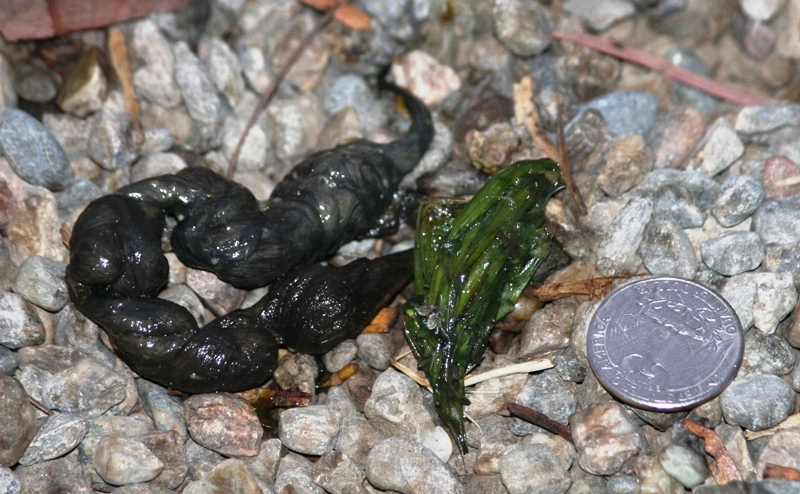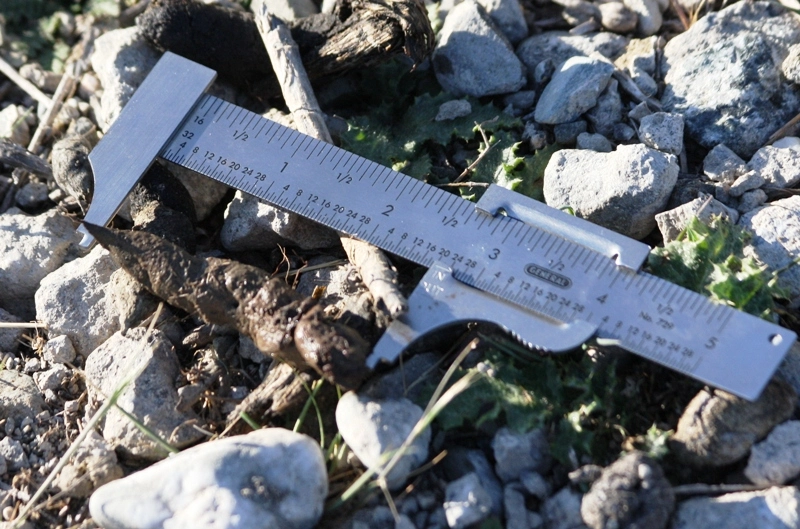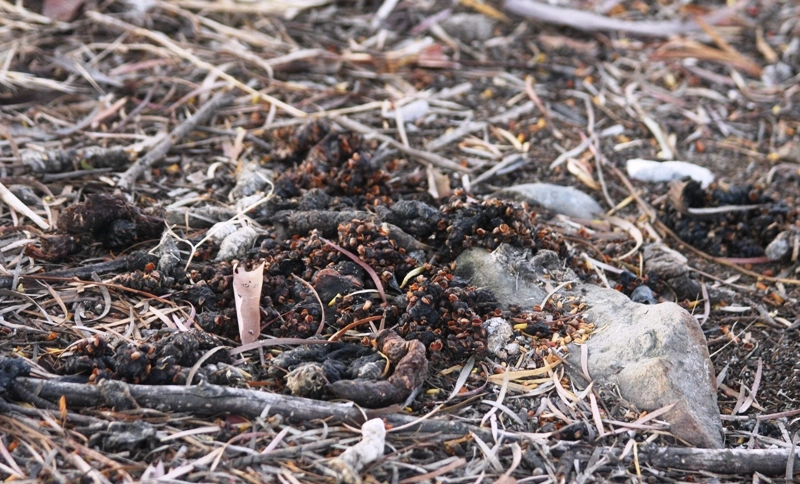Uses of and the Importance of Scat
by William C. Leikam
President, CEO & Co-founder, Urban Wildlife Research Project

Many people shy away from discussions on scat, or feces as they are politely called. Back some time ago, before Covid, when I first brought it up in my public walk-talks over at Don Edwards San Francisco National Wildlife Refuge, kids especially would go, “Ooaa, yucky.” However, once out on the trail and we began finding these smelly deposits, they began to understand and indeed they went the rest of the hour-long walk looking for scat, wanting to know more about it.
So, gray fox scat falls within the category of canine scat. For instance, that could include not only foxes but your pet dog, or a range fed coyote. Gray fox scat is 22 millimeters or less in diameter with one end tapered often to a point and the other end blunt. (That’s according to those folks who make such determinations.) Now that could be the description of a small dog’s scat, so in order to make a determination as to what kind of a canid left that scat, we have to break it open and examine its contents. (One should always wear latex gloves or other such protection when handling it and never handle scat that has turned white even with gloves.)

How do we know that it’s gray fox scat? If a domestic dog, then we would expect to find kibble, or something similar; off the shelf dog food. If it were a domestic dog, then one would not expect to see 95% of it gray fur and sometimes splinters of bone. If the latter is found, then one can narrow it down to a wild canine. Then knowing the area, what wildlife lives in the region, a reasonable conclusion can be drawn given all indicators that this scat is from a gray fox.
Scat tells us what the foxes eat. Laimos, the male in our study area, has lately been eating a lot of grass, a particular broad leaf weed that grows in his vicinity, whereas his mate Big Eyes has been seen on our trail cameras bringing in rabbits, both cottontails and jack rabbits. She most likely caches them. Her scat is full bodied and filled with fur, whereas his is small and often knurly consisting of grass and possibly some small amount of fur for he is not strictly a vegetarian.
The collaring project needs in excess of $35,000 and here’s the reason why you should consider a donation to UWRP be it $1 or $5,000 so that we can begin the collaring project dedicated to making the baylands along the San Francisco Bay a healthy place for wildlife to live. You can donate through PayPal or Give Direct, our preferred portal for giving. On our website (Urban Wildlife Research Project), check out the short video and go to the donate button nearby. Your donation is tax deductible.
Check out our Facebook page.
Check out our YouTube Channel at https://www.youtube.com/channel/UC5ujc7p8dU1-O5AbPAWz2_Q
Check out Bill’s interview of January 1, 2021, hosted by the Town of Woodside California for their First Friday event at https://youtu.be/QrZzvmrqKTA
Radio interview – KALW (Local PBS) Audio Recording Interviewed by Sofie Kodner during December 2020 – Broadcast 1/11/2021 5:00 PM on PBS’s program Crosscurrents https://www.kalw.org/post/bay-area-wildlife-habitats-are-disappearing-fox-guy-has-plan
Bill will be doing an online show, a how to draw workshop featuring the gray fox with the renowned artist John Muir Laws on January 14, 2021. It will air from noon until 1:00 or 1:30 PM. https://johnmuirlaws.com/
You can access Bill’s PowerPoint presentation Corridors & Connections: Sustaining the Health of All Wildlife presented during the October 24th P-22 Urban Wildlife Festival here: https://www.youtube.com/watch?v=Dh4MQL1D1Cc
NEW – To find out more about us, search Urban Wildlife Research Project, UWRP, gray foxes, wildlife connection, linkages, corridors and several documentaries and clips on https://www.youtube.com/channel/UC5ujc7p8dU1-O5AbPAWz2_Q
If you haven’t had a chance to read some of the articles that have been written about our study of gray fox behavior and our corridor work, click on these links as they will take you to the source: Bill Leikam – The Fox Guy, and Greg Kerekes & URWP
Section III
Gray Fox, Baylands Goals
Within the permit that allows the Urban Wildlife Research Project to conduct its study of the behavior of the gray fox at the Palo Alto Baylands Nature Preserve, the objectives covered area:
- Monitoring of urban gray fox Denning sites in Palo Alto Baylands.
This is being accomplished during the period when the gray foxes use a den site. It is one of the prime locations for gathering most of the behavioral data of the litter and for adults alike.
- Assessment of status and population trends of Baylands urban gray foxes
Since January 2019 a pair of resident gray foxes have claimed territory at the Palo Alto Baylands Nature Preserve.
- Identification of habitat features that promote the presence of urban gray foxes
After considering this and talking with people who know how to restore habitats, we need to assess what kinds of plants, including the Alkaline Salt Bush, would grow best along the edge of the saltwater channel and alongside the marsh. We need to grow a permanent habitat that contains the corridors and plant it as soon as possible. We’ll keep an eye on this as this is a critical link between the southern region of the Baylands and the northern region.
- Assessment of reproductive success and identification of factors that promote successful reproduction
Open up the pinch-point along Matadero Creek by developing thickets that link one area to another, instead of the present “islands”.
- Identification and assessment of possible dispersal travel routes.
Presently there can only be guesses as to dispersal travel routes. We intend to make this important question much more concrete when we attain our collaring/take/capture permit from the Department of Fish & Wildlife.





